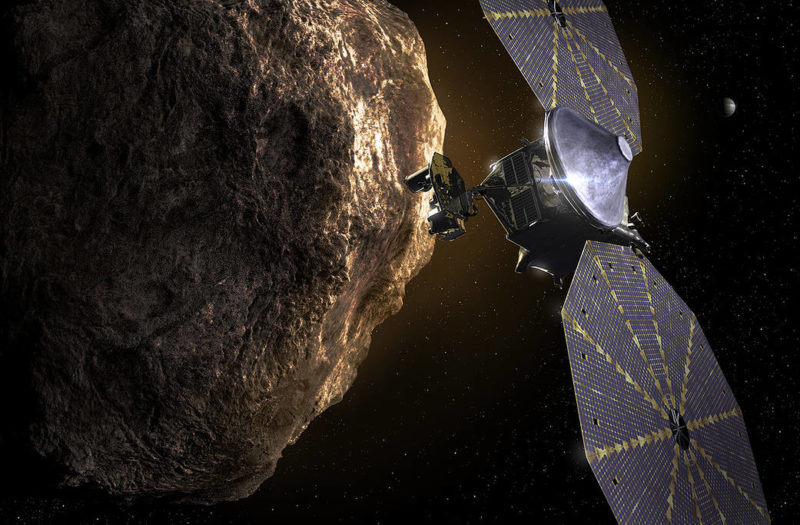
NASA and United Launch Alliance (ULA) are counting down to tomorrow’s 5:34 a.m. EDT launch of a mighty Atlas V rocket from Cape Canaveral Space Force Station, Fla., laden with the ambitious Lucy mission to explore multiple Trojan-class asteroids which lead or trail the orbital path of giant Jupiter. The “Mighty Atlas”—flying in its workhorse “401” configuration, with a 13-foot-diameter (4-meter) payload fairing, no solid-fueled strap-on boosters and a single-engine Centaur upper stage—will lift off from storied Space Launch Complex (SLC)-41, two hours before sunrise. The mission will kick off a 12-year odyssey for Lucy, which will traverse four billion miles (6.4 billion kilometers) and visit some of the most ancient and puzzling worlds in our Solar System.
Weather conditions for Saturday’s opening launch attempt are expected to be 90-percent favorable, tempered by a slight risk of infringing the Cumulus Cloud Rule. A surface high, situated to the southeast of the Space Coast, is expected to settle directly over Central Florida by the weekend, bringing “continued pleasant weather and light winds”, according to the 45th Weather Squadron at Patrick Space Force Base. However, in the event that the attempt is scrubbed, Sunday and Monday look decidedly more pessimistic, with the arrival of a cool front and a chance of showers and high winds.
Lucy first entered consideration as a mission to the outer Solar System in September 2015, when NASA listed it as one of five conceptual designs for funding under the low-cost Discovery Program. Led by Principal Investigator Dr. Harold Levison of Southwest Research Institute (SwRI) in Boulder, Colo., Lucy received an initial $3 million funding package for preliminary design and analysis. A year later, in September 2016, the space agency began the process of selecting two finalists and in January 2017 Lucy made the cut, alongside the Psyche mission, which will visit a metallic asteroid of the same name.
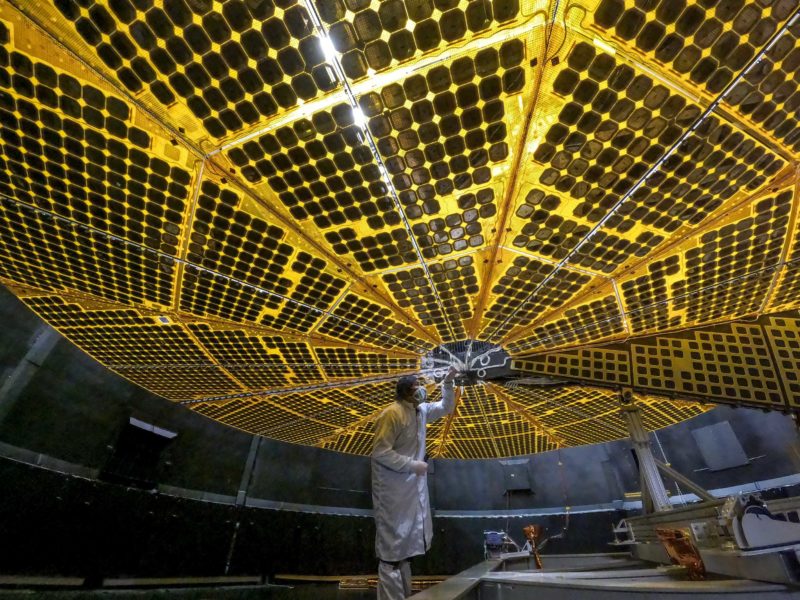
Designed to enable low-cost missions with a funding ceiling of around $450 million, the Discovery Program has seen 12 epic voyages since the Near Earth Asteroid Rendezvous (NEAR) Shoemaker, which launched in February 1996 to visit, orbit and soft-land on asteroid 433 Eros. Since then, other Discovery missions included Mars Pathfinder and its Sojourner rover, the Mercury-bound MESSENGER orbiter and the Kepler observatory. Most recently, in November 2018, NASA’s InSight lander touched down on Mars to investigate the deep (and surprisingly active) interior of the Red Planet.
With Lucy set to be the 13th Discovery mission, her name honors the famous Australopithecus afarensis hominin skeleton found in Ethiopia in 1974 and now recognized as one of humanity’s earliest forebears. Fittingly, the robotic Lucy will visit several worlds in the outer Solar System which are themselves “fossils” from the early Solar System.
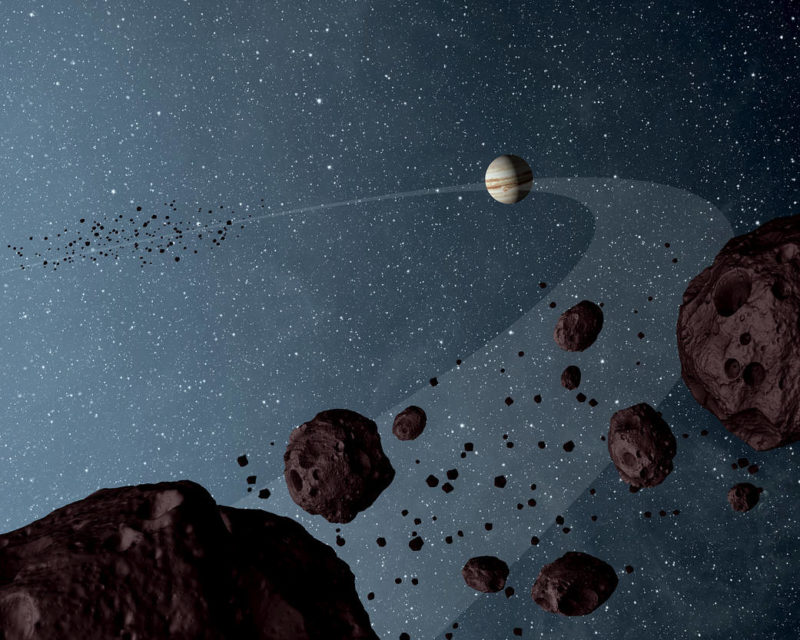
So-called Trojan asteroids typically occupy stable orbits “ahead” or “behind” a large planetary body at the gravitationally-balanced L4 or L5 Lagrange Points. And although thousands of Trojans are currently cataloged, and have been detected in the vicinities of Mars, Neptune and even Earth itself, the vast multitude are associated with Jupiter.
These ancient objects drew their naming convention from characters on the opposing Greek and Trojan camps in the classical tale of Troy. The “Greek Camp” typically resides at the L4 Point, ahead of Jupiter, with a “Trojan Camp” at L5, trailing the giant planet. However, one of Lucy’s targets—617 Patroclus, which honors Achilles’ Greek companion—is an exception to this rule, having been assigned to the Trojan Camp before the naming convention came into effect. It is believed that millions of Jovian Trojans exist, perhaps equivalent to the amount of small bodies in the classical “asteroid belt” between the orbits of Mars and Jupiter.
Gravitationally trapped for billions of years, caught betwixt the competitive tug of the Sun and Jupiter, these primordial bodies represent leftovers of the building-blocks from the giant planets and Lucy’s mission is expected to reveal fundamental clues about their origins. “This is a unique opportunity,” said Dr. Levison after the January 2017 selection. “Because the Trojans are remnants of the primordial material that formed the outer planets, they hold vital clues to deciphering the history of the Solar System. Lucy, like the human fossil for which it is named, will revolutionize the understanding of our origins.”
In October 2019, Lucy finished her Critical Design Review (CDR) at prime contractor Lockheed Martin’s facility in Littleton, Colo., which ticked off her remaining technical obstacles, validated her mission architecture and permitted the onset of work to assemble her spacecraft “bus” and subsystems.
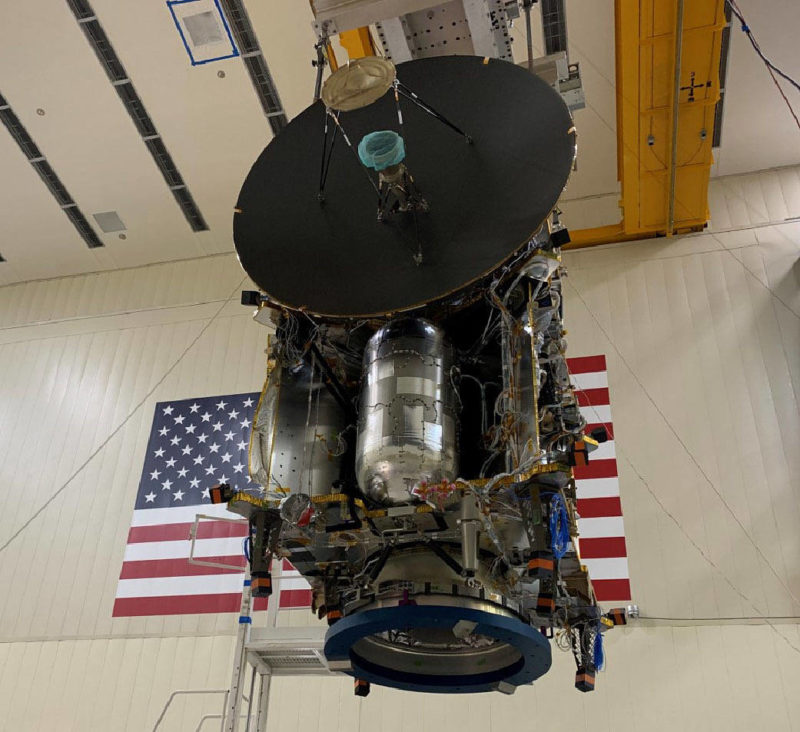
Measuring over 45 feet (13 meters) between the extremities of her immense solar array “wings”, the 3,300-pound (1,500-kilogram) she carries three scientific instruments, which are upgrades of hardware from the New Horizons mission to Pluto and the Kuiper Belt and the now-homeward-bound OSIRIS-REx.
Those instruments will be brought to bear on some of the strangest and most enigmatic celestial bodies in the Solar System; objects so ancient that they may represent the primordial building blocks of the planets themselves, originating only a few tens of millions of years after the Sun itself ignited. Additionally, Lucy’s on-board terminal tracking camera and 6.5-foot-wide (2-meter) high-gain communications antenna will also be put to work in support of mission science goals.
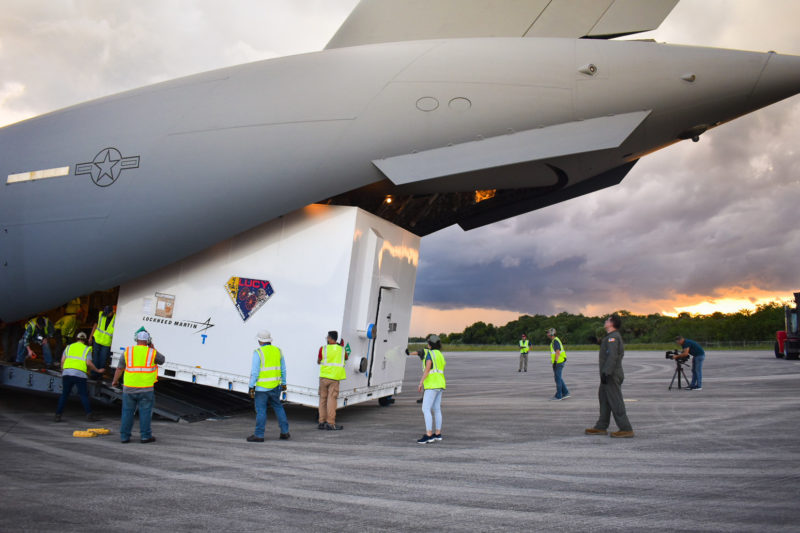
The Lucy Long Range Reconnaissance Imager (L’LORRI), built by the Johns Hopkins University Applied Physics Laboratory (JHU/APL) in Laurel, Md., is derived from a similar tool on New Horizons and will image the Trojans’ surfaces. L’Ralph, another descendent of a New Horizons instrument, supplied by NASA’s Goddard Space Flight Center (GSFC) in Greenbelt, Md., furnishes Lucy with a panchromatic and color visible imager and infrared spectroscopic mapper for measuring silicates, ices and organics. And the Lucy Thermal Emission Spectrometer (L’TES), provided by Arizona State University in Tempe, Ariz., will explore the Trojans’ thermal infrared characteristics.
“This is a thrilling mission as the Jupiter Trojan asteroids have never been studied up close,” said Guy Beutelschies, director of interplanetary systems at Lockheed Martin Space Systems. “The design of the spacecraft draws from the flight-proven OSIRIS-REx spacecraft. This heritage of spacecraft and mission operations brings known performance, reliability and cost to the mission.”
In the summer of 2020, Lucy passed through her Systems Integration Review (SIR) and the Assembly, Test and Launch Operations (ATLO) team was green-lighted to begin integrating segments, components and subsystems, scientific instrumentation and electrical, communications and navigation systems.
The ATLO phase got underway in September 2020 and early last spring Lucy completed a successful deployment test of her twin solar arrays, which will operate at a record-setting 530 million miles (850 million kilometers) from the Sun. The arrays will supply Lucy with 500 watts of power, roughly enough to run a washing machine, and this is the farthest a solar-powered Discovery Program mission has ever traveled.
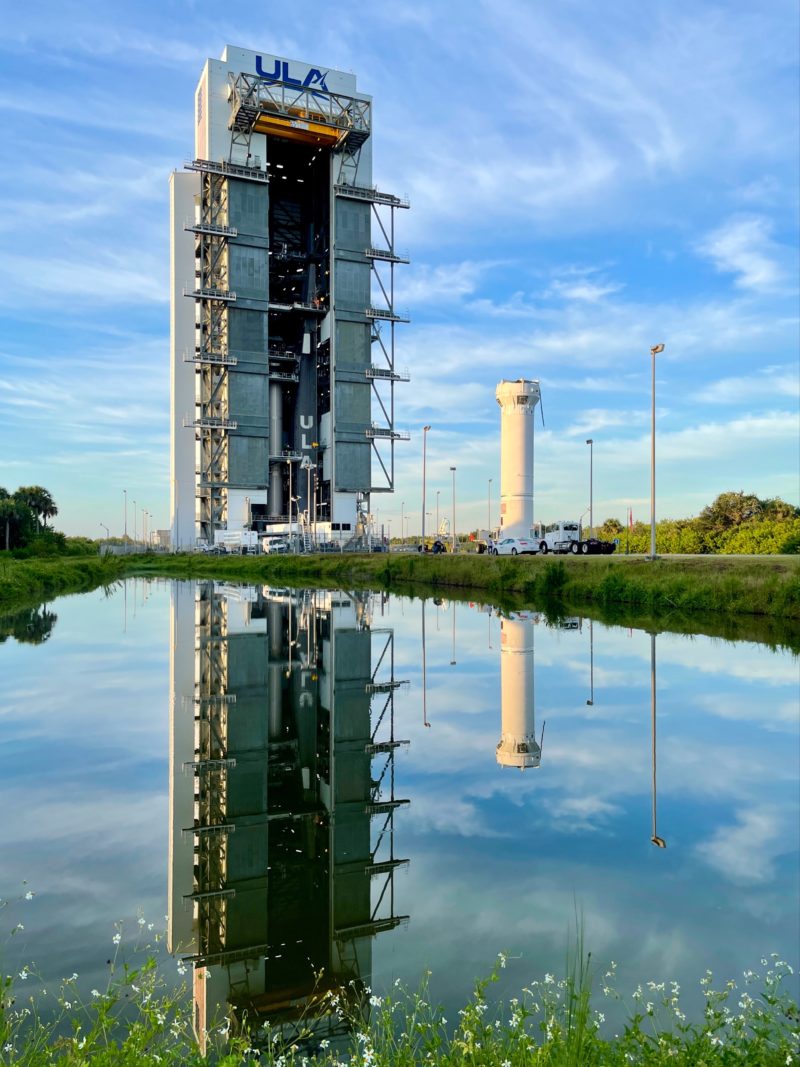
At the end of July, with testing complete, Lucy was airlifted via a C-17 cargo transport from Buckley Space Force Base in Aurora, Colo., to Cape Canaveral Space Force Station, Fla., whereupon it was removed from its container, inspected and ensconced in the Astrotech Space Operations clean room in nearby Titusville for pre-launch processing.
“The coronavirus pandemic required us to re-engineer the way we conducted assembly, integration and testing,” said Lucy Project Manager Donya Douglas-Bradshaw of NASA-Goddard. “When I think about where the project was a year ago, and the challenges we faced, I couldn’t be prouder of the entire team.”
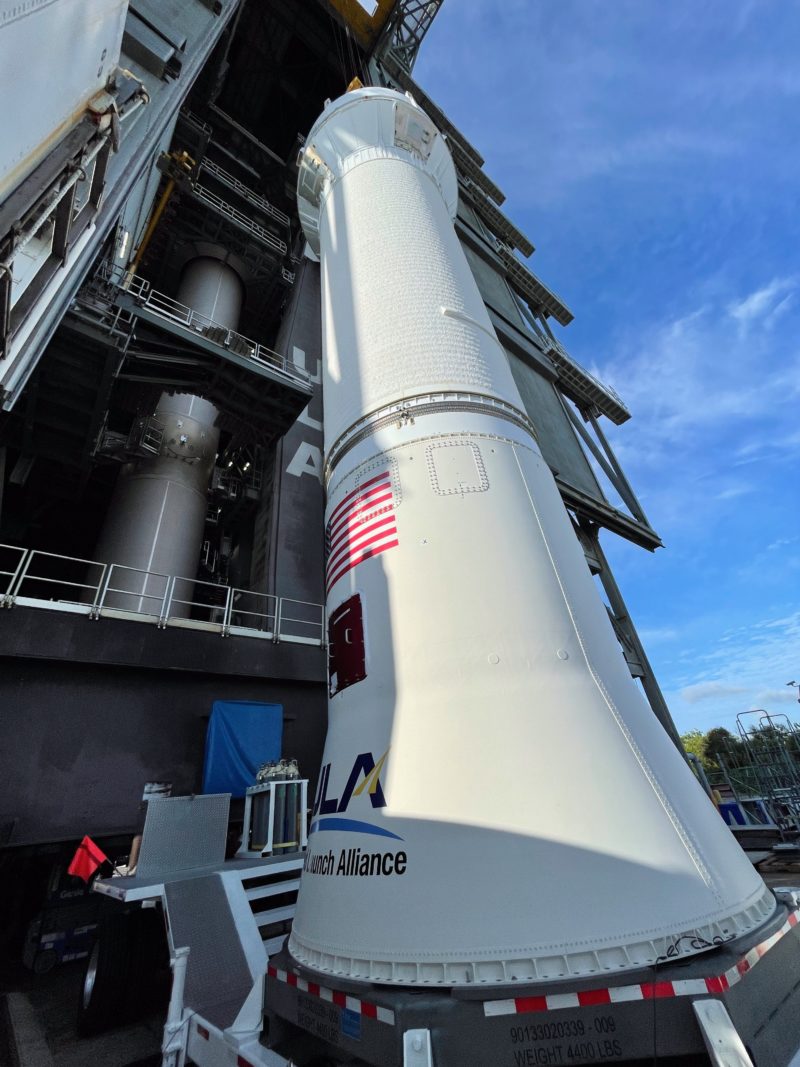
Elsewhere, the launch hardware was coming together, albeit from an unusual source. ULA had won the $148.3 million contract in January 2019 to launch Lucy atop its workhorse Atlas V 401 booster. This particular variant of the long-serving rocket has supported 39 of all 88 Atlas V missions between August 2002 and last month’s launch of Landsat-9 from Vandenberg Space Force Base, Calif.
But as circumstances transpired, the delay of the long-awaited second Orbital Flight Test (OFT-2) of Boeing’s CST-100 Starliner to the International Space Station (ISS) in early August worked unexpectedly to Lucy’s advantage. Its strap-on boosters and Dual-Engine Centaur (DEC) were destacked and placed into storage, but the 107-foot-tall (32.5-meter) Atlas V Common Core Booster (CCB) was kept in the Vertical Integration Facility (VIF) at SLC-41 and repurposed for Lucy.
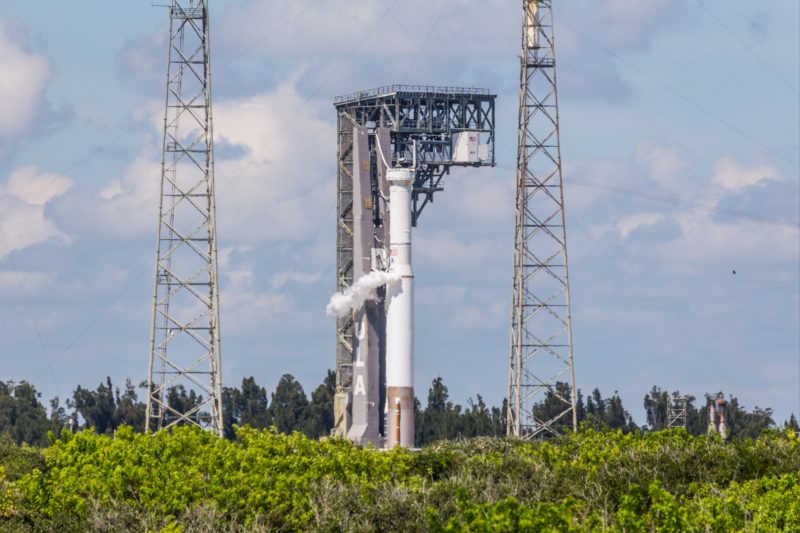
“We will be using the booster for Lucy,” ULA CEO Tory Bruno confirmed in a 16 August tweet, “allowing it to stay in the VIF.”
A month later, on 16 September, the 41.5-foot-long (12.6-meter) Centaur upper stage arrived at the VIF and was hoisted into place atop the Atlas V. As is customary for missions with narrow launch windows, a Wet Dress Rehearsal (WDR) was completed on 1 October, during which the stack was transported to the pad and fueled with 66,000 gallons (300,000 liters) of cryogenic oxygen and hydrogen.
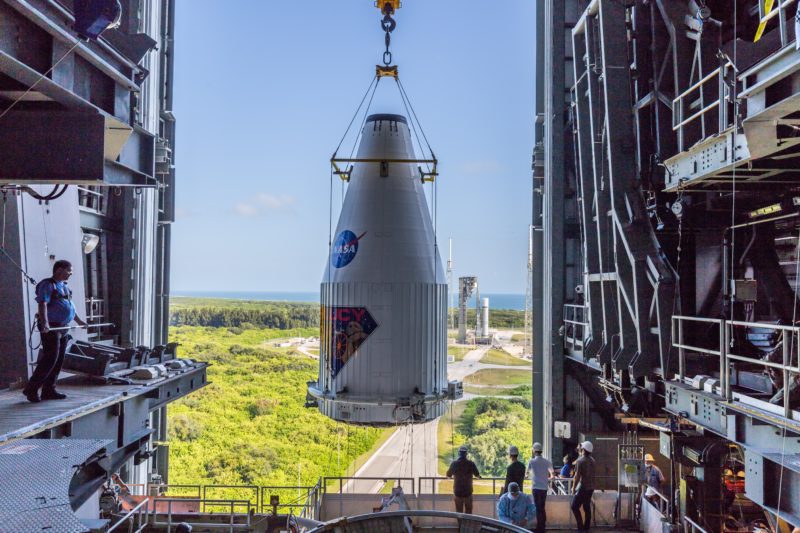
These “wet”—or fully-fueled—demonstrations serve to mitigate issues that may arise during the real launch campaign. Following the WDR, the Large Payload Fairing (LPF), bearing Lucy, was added to the stack on 7 October. This topped-off the Atlas V at an impressive 188 feet (57.3 meters) tall.
Yesterday, under the deft leadership of NASA Launch Manager Omar Baez, the Launch Readiness Review (LRR) came to a satisfactory conclusion with the signing of the Launch Readiness Certificate. Also on Thursday, the Atlas V was rolled out from the confines of the 300-foot-tall (90-meter) VIF and an hour later was declared “hard-down” on the SLC-41 pad surface. Opening tomorrow and extending through 7 November, Lucy’s 23-day “launch window” will enable it to visit multiple worlds over the next dozen years.
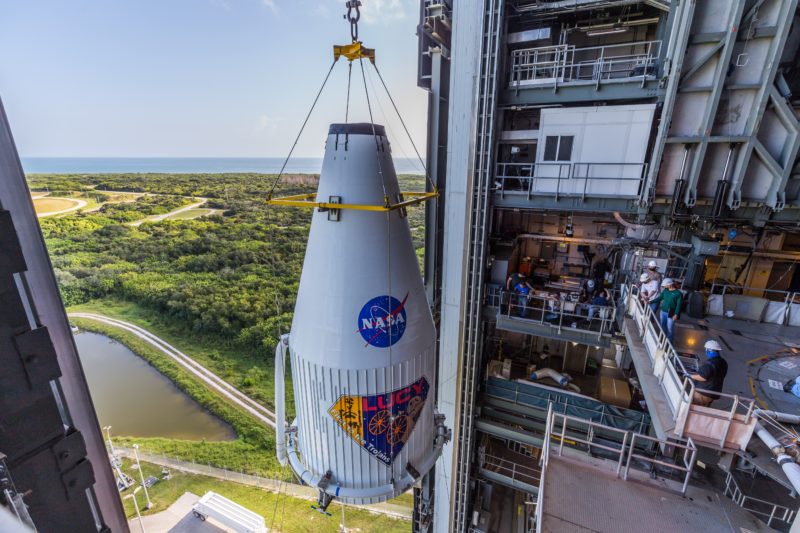
Within an hour of launch, Lucy’s fan-like solar arrays will deploy and secure themselves into position. Its trajectory over the coming years will see it conduct a pair of Earth Gravity Assist maneuvers in October 2022 and December 2024, before it tests its mettle by surveying the “main belt” asteroid 52246 Donaldjohanson in April 2025. This particular asteroid lies some 220 million miles (350 million kilometers) from the Sun and measures only about 2.5 miles (4 kilometers) in diameter.
Named for the palaeontologist Dr. Donald Johanson, who found the skeletal Lucy, it is a relatively common, C-type or “carbonaceous” asteroid. Lucy will pass it at a distance of 570 miles (920 kilometers) and test its capabilities before its first encounter with a true Trojan.
First up are four members of the Trojan Camp, led by 3548 Eurybates, which measures about 42 miles (68 km) across and in January 2020 was verified by the Hubble Space Telescope (HST) to possess its own natural satellite, now named Queta. Six thousand times fainter than Eurybates itself, implying a diameter no greater than a half-mile (1 kilometer), Queta promises to be one of the smallest objects ever visited by a spacecraft.
Five weeks after its August 2027 Eurybates-Queta encounter, Lucy will sweep just 260 miles (420 kilometers) past the tiny, reddish-hued 5094 Polymele, before heading to survey the mid-sized, slow-rotating 1351 Leucus in April 2028 and the exceptionally dark 21900 Orus the following November.
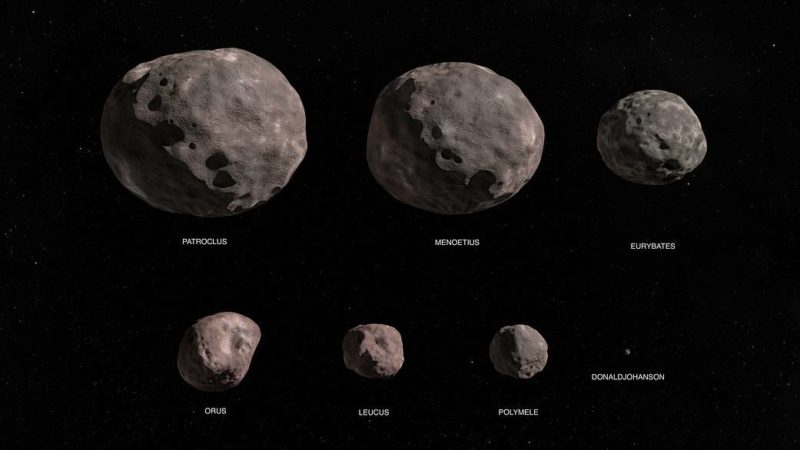
With the completion of these four Trojan visits, the spacecraft’s trajectory will carry it back toward the inner Solar System for its third Earth Gravity Assist in December 2030 to propel it toward its final planned targets. This is the “binary” Trojan 617 Patroclus, in the Greek Camp, which it will encounter in March 2033. Measuring about 70 miles (110 km) across, it has a companion, Menoetius, which is only 10 percent smaller than Patroclus. The two objects reside about 420 miles (680 km) apart.
Lucy will conduct imaging of each of its asteroidal quarries, searching for traces of silicates, ices and carbonates and measuring their thermal spectral signatures and masses. And getting to each of them has proven to be a marvel of trajectory planning.
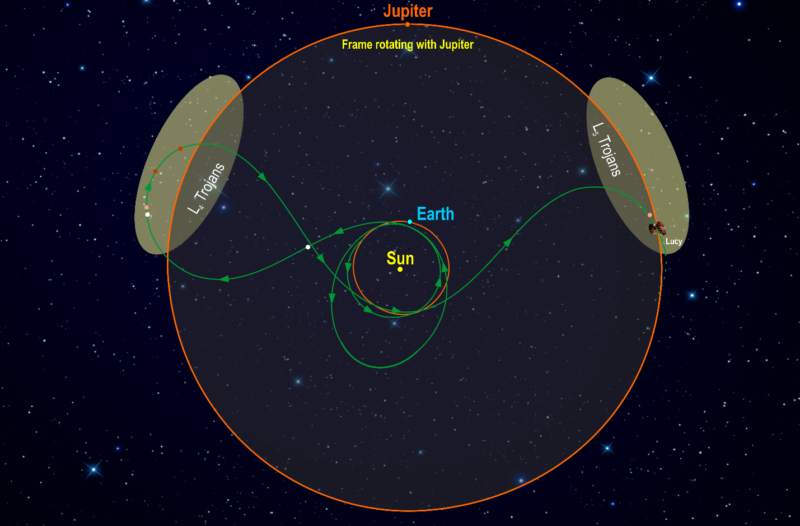
“There are two ways to navigate a mission like Lucy,” said optimization technical lead Jacob Englander. “You can either burn an enormous amount of propellant and zigzag your way around, trying to find more targets, or you can look for an opportunity where they just all happen to line up perfectly. As such, Lucy’s high-speed lane-changes will be effected through gravity-assisted boosts, with minimal fuel usage.
And although Lucy’s closest approaches to its primary targets—Donaldjohanson, Eurybates/Queta, Polymele, Leucus, Orus and Patroclus/Menoetius —are expected to be over in a matter of hours, the spacecraft itself will occupy an orbit that will likely remain stable for 600,000 years. Just like its prehistoric ancestor, who walked the plains of Ethiopia three million years ago, so her robotic descendent will wander the outer Solar System until perhaps someday another human gets to see her again.




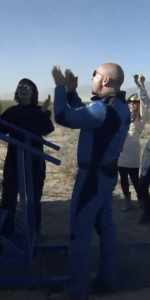
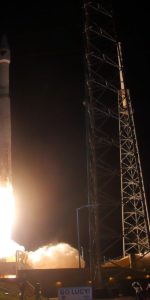
One Comment
One Ping
Pingback:Weather Looks Favorable for Before-Dawn Saturday Launch of Lucy Mission